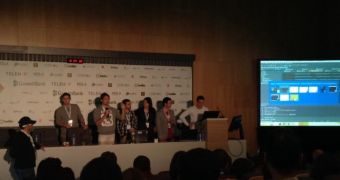A team of six Romanian students developed an application that can track eye movement in order to determine the numbers of a PIN, thus allowing a hands-free input.
The students coded the app in 18 hours during a hackathon named Techsylvania, that ended at the beginning of June in Cluj-Napoca, Romania. They are the winning team of the competition and all of them attend the Faculty of Mathematics and Computer Science at Babes-Bolyai University in Cluj-Napoca.
SecureEye, as the application is named, receives the input from an eye-tracking device and determines the numbers the user looks at. The tracking is carried out through sophisticated mathematical algorithms and relies on infrared scanning to discover the object targeted by the eye.
One of the winners, Anca Davidel, said that their project could be useful in making cash withdrawals from ATMs more secure, since there is no risk of someone seeing your PIN code during the operation. She also said that the technology could also be extended to home security systems.
The device checking the eye movement used by the students is called The Eye Tribe Tracker, it costs $99 / 73 EUR and incorporates USB 3.0 technology.
According to Mediafax, Davidel tested the application with the tracking device connected to a laptop and managed to type in a four-number code by simply looking at the symbols.
It appears that logging into the application and determining the PIN code takes about six seconds. Moreover, the distance between the eye and the display is about 65 centimeters (25.6 inches), which would make it feasible for computer password replacement in the case of most people.
Spherik Accelerator, a program dedicated to Romanian students who develop new technology during different competitions, offered the winning team their own office for a period of six months, where they can continue working on the project and maybe create their own startup.
The team is composed of Ioan Lup, Gereb Istvan, Lorand Ignat, Ovidiu Roşu and Lucian Ziman, and it seems that they have already received invitations to present their project from companies in Germany and France.
This year was Techsylvania’s first edition and the event was attended by over 400 programmers, managers of IT companies, and businessmen.
More than five different wearable technologies were available for hacking and app development purposes. The hackathon consisted in a 24-hour session of coding, at the end of which the result needed to have a functional purpose.

 14 DAY TRIAL //
14 DAY TRIAL //